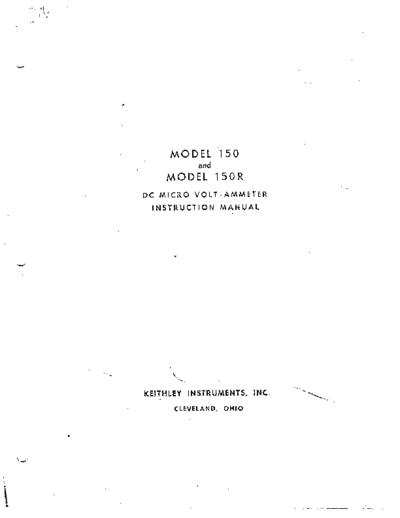Service Manuals, User Guides, Schematic Diagrams or docs for : Keithley 150 150(Model150and150R)
<< Back | HomeMost service manuals and schematics are PDF files, so You will need Adobre Acrobat Reader to view : Acrobat Download Some of the files are DjVu format. Readers and resources available here : DjVu Resources
For the compressed files, most common are zip and rar. Please, extract files with Your favorite compression software ( WinZip, WinRAR ... ) before viewing. If a document has multiple parts, You should download all, before extracting.
Good luck. Repair on Your own risk. Make sure You know what You are doing.
Image preview - the first page of the document

>> Download 150(Model150and150R) documenatation <<
Text preview - extract from the document
MODEL `150
and
MODEL l5OR
' .
DC MICRO VOLT-AMMETER
INSTRUCTION MANUAL
KEITHLEY INSTRUMENTS, INC. "`1,
CLEVELAND, OHIO
SECTION
INTRODUCTLON . . . . . . . . . . . . . . . . . . . . . . . . . . . . . . . . ..I.....
. 1 .'
SPECIl~ICA~IONS .,.,..*..*............**.........**.... II
OPJ3RATION. . . . . . . . . . . . . . . . . . . . . . . . . . . . . . . . . . . . . . . . . . .
. III
A. Operating Controls
B. Preliminary Set-up
C. General Precautions
1. source Reoistance
2. Shielding '
3. Thermal EMF
4. Input Noise
5. Checking the Zero Point
D. Meaouring Voltage
1. Direct Moaswement
2. Small varib.tions
3. Differential Voltages
E. Measuring Current
1. Dire& 14oasurcment
2. Small Variations
F. Other Applications
1. Null Indicutor
2. Megohmwter
CIRCUIT DESCRIPTION .,*............*.,*.,.,........... Iv
A. Input Circuit
B. AC Amplifier
C. DC Amplifier
D. Zero Supprension
E. Other Controls;
F. Power Supply
,,,,,..........*.......*,..*...,.......**.
MAINTENANCE V
General Notes
Trouble Shooting
Volta&c-Renistance Diagram
Circuit Schematic Diagram
Replaceable Parts List
SECTION I - INTRODUCTION
The Model 150 Micro Volt-Ammeter is a stable, versatile instrument
for measuring extremely low level DC signaln. It functions a6 a
voltmeter i9`om one microvolt to one volt full scale, and as an
ammeter from one milliampere to one hundred micro-microampere8
full scale., It aloo opcratev as a DC amplifier with gains up to
ten million for driving recordertl.
The very low noise level of the Model 150, together with ite long
term stability rrake it ideal for many meaouromcnto requiring c;:-
treme power nensitivity.
Typical applications include mca,suring the output from strain gages,
thermopilos, thermocouples, bolometers, phototubes, ionization chanlbtirs,
oclntillation countors, and barrier layer cells. Other applications
are found in cell studies, measurement of electrochemical potcn-cials,
electrolytic corrosion studies, molecular weight analysis and Hall
effect studies.
In addition to its use as a direct indicator of minute potentialo
and currents, the Mod01 150 may also be used as a null detec~tor In
Wheatstone or Mueller bridges, or with an external voltage source
ao a meg-me&ohmmeter. .
An important feature of the inritrument is zero supprenoion up to
100 times full scale, in place of the usual more limitod~ meter zero.
This permits measurements of small oignala in the presence of large
thermal EMF's or other masking DC signals.
I -1
SXTION II - SFXIFICATIOPIS
VOLTXTX~ SrPECIFICATIONS
RANGES: 13 overlapping ranges in lx and 3x sI;cps from 1
microvolt to 1 volt full wale on n zero-cqnt.cr mster.
Zl:ill Cc.ncra1l.y
drift off scale on any voltage range. On current ranges ihis does
not happen bocauso of the input ohuntinC resistors.
2. Shielding - Since the instrument operates with a mo3~~lo.t~ fx-
quoncy of 120 cps, it is not generally sensitive to 60 cpn pickup
unless it is large enough to overload the amplifier. The pickup :n;y
be a source of difficulty when using the amplifier \Tith high imPeri-
axes ox the more sensitive voltage rzngcs and on the t-.zo or three
most sensitive current ranges. In these cases it is desirable to
shiold,thc leads and the source 3s completely as possible. In ooiae
cases a simple low-pass filter at the input to eliminate frec,uoncies
of about 1 cps and above will be helpi'ul. No use is made of an inout
filter in this instrument since any input series impcdxince 13.x to :he
filter will increase the input noise and the thermal drift. When o,p-
eratine above ground, the case of the instrument must be Croundcd.
3. Thermal EKF - Extreme precautions have been taken in the input
circuit to minimize thermal EMF's so that the residual FXF is less
than 0.6 microvolt. The material used in the input circuit is pure
copper. Any other metal will generat a thermoco)u?le potential.
Load solder is perticularly troublesome. lihero thermal EXF's are a
problem, soldering should be done with the cadmium-tin solder supplied
with the instrunont.
4. Input Noise: The noise at the input is a function of input re-
sistance and is approximately given by
E = 1.29 x 10-10 (R+2000)$
where E Is the IWS noise, and R is the source resistance. It Is as-
sumed that the bandwidth of the instrument is about 1 cps and the
temperature is 80 ◦ Jabse Service Manual Search 2024 ◦ Jabse Pravopis ◦ onTap.bg ◦ Other service manual resources online : Fixya ◦ eServiceinfo